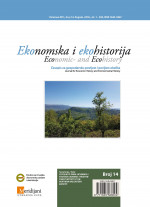DEFORESTACIJA I REFORESTACIJA U HRVATSKOME DINARSKOM KRŠU: ODNOSI I IMPLIKACIJE
DEFORESTATION AND REFORESTATION IN CROATIAN DINARIC KARST: HUMAN-ENVIRONMENTAL RELATIONS AND IMPLICATIONS
Author(s): Borna Fuerst-BjelišSubject(s): Human Ecology, Environmental interactions, 18th Century
Published by: Društvo za hrvatsku ekonomsku povijest i ekohistoriju - Izdavačka kuća Meridijani
Keywords: deforestation; reforestation; Dinaric karst; Croatia;
Summary/Abstract: The paper presents specific human – environmental relations in the Croatian Dinaric karst, as a unique natural environment characterized primarily by water permeability of the soil, highly localized zones of cultivable soil and under the strong influence of the Mediterranean climate with regular dry periods. These circumstances led to the development of the subsistance economy, which has been largely determined through pastoral history. The paper gives a brief overview of these relations from the Neolithic to the Modern Age, while from the 18th century it further details the process of deforestation and reforestation on the basis of the results of more recent case studies research from different areas of Croatian Dinaric karst – Svilaja mountain, dry lowland of Zagora, Hvar island and the coastal Šibenik area. Long-term overgrazing in the fragile Mediterranean karst environment with the addition of forest clearing for the purpose of timber production and increasing the arable and pasture area caused a significant development of the deforestation process until the 19th century. Depopulation that first began on the islands at the beginning of the 20th century due to the collapse of the island economy based on vine production, and since the middle of the 20th century in the Dalmatian interior mainly due to the intensive littoralization process, resulted in the land abandonment and triggering the reforestation process. The process of reforestation is characterized by the spread of degraded forms of forests, shrubs and maquis as well as by the degradation of the elements of cultural landscapes – drywalls and terraces and the disappearance of vineyards as cultural and traditional values of space.
Journal: Ekonomska i ekohistorija - Časopis za gospodarsku povijest i povijest okoliša
- Issue Year: 2018
- Issue No: 14
- Page Range: 136-144
- Page Count: 9
- Language: Croatian

